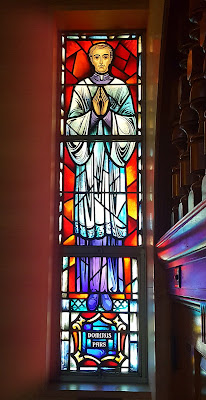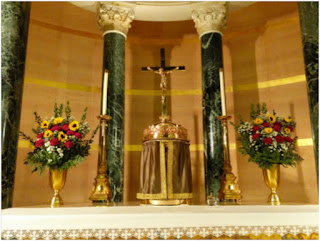Shear My Will & Become My Portion, O Lord
 Upon opening the doors into the St. Mary’s Seminary Chapel,
you are mesmerized by the beauty of the golden apse. Then, your focus likely
shifts to the stained glass found throughout the chapel, but before taking
another step, to your immediate right you can see this small stained-glass
window with an image of a seminarian, vested, standing, with his hands joined
together in prayer, and with a small bald spot on his head. The reception of
the Tonsure (to shear) as depicted
here is actually an ascription prior to entering the minor orders (Porter, Reader, Exorcist, and Acolyte) which
came before entering major or holy orders (Deacon
and Priest).
Upon opening the doors into the St. Mary’s Seminary Chapel,
you are mesmerized by the beauty of the golden apse. Then, your focus likely
shifts to the stained glass found throughout the chapel, but before taking
another step, to your immediate right you can see this small stained-glass
window with an image of a seminarian, vested, standing, with his hands joined
together in prayer, and with a small bald spot on his head. The reception of
the Tonsure (to shear) as depicted
here is actually an ascription prior to entering the minor orders (Porter, Reader, Exorcist, and Acolyte) which
came before entering major or holy orders (Deacon
and Priest).
This initial progression to the priesthood involved shearing
the candidate’s hair as a sign of his dedication to the service of the God. This
sacred rite, as instituted by the Church, allowed the candidate discerning the
priesthood to be received into the clerical order by shearing of his hair and
by investment with the surplice. These visible signs illustrated the committed
dedication of a young man’s sacrifice to denounce finite things and with an
undivided heart, seek to answer his calling from God. Also, as the seminarian
progressed on his journey, the sheared head symbolized setting
aside his lay state and entering the clerical state where he would begin to
conform himself to be a priest, an Alter-Christus for the Church. Before this Tonsure
was introduced to the Church, it actually began with parents offering their
young sons to the service of God. This emphasizes the fruitful involvement of
the family, the domestic church, who would initiate and strengthen the gift of
Faith. As opposed to complying with a traditional duty of the Faith or simply
dropping off the children in Formation classes, the domestic church took on an
active role when they too shear off their will by walking this journey of Faith
with their children.
 In a distinctive way, we see his hands joined in prayer and
a red background, symbolizing a submitted will to the sacrificial nature of
wearing the Tonsure. This young man must now undividedly dedicate himself to
the service of God by his renunciation of the world and its allurements. The
renunciation of worldly things does not make a person miserable or socially
disabled. Rather, by actively listening to God’s voice, he delights in infinite
things and is continuously present to those who live in the world by sharing
his gifts perfected by God to parishioners, family, co-workers, or anyone he
encounters. As members of the body of Christ, we too are called to present
ourselves with an uncircumcised heart to God through a daily submission of our
will. Fed with the sacraments, all must accept a “spiritual tonsure” to root
out anything that keeps us from being ready to serve our Lord.
In a distinctive way, we see his hands joined in prayer and
a red background, symbolizing a submitted will to the sacrificial nature of
wearing the Tonsure. This young man must now undividedly dedicate himself to
the service of God by his renunciation of the world and its allurements. The
renunciation of worldly things does not make a person miserable or socially
disabled. Rather, by actively listening to God’s voice, he delights in infinite
things and is continuously present to those who live in the world by sharing
his gifts perfected by God to parishioners, family, co-workers, or anyone he
encounters. As members of the body of Christ, we too are called to present
ourselves with an uncircumcised heart to God through a daily submission of our
will. Fed with the sacraments, all must accept a “spiritual tonsure” to root
out anything that keeps us from being ready to serve our Lord.
Another feature is the cassock underneath the white
surplice. This black cassock symbolizes the dying to self and dying to the
world. An interesting feature of the cassock is its pockets, which ought to be used
to store all those things which we are called to share with others. The
marginalized will “appreciate a little money, your smile, and a word of solace
more than your impeccable hymn signing.” [1]
For a seminarian, wearing the cassock may be something he delights in because
he is finally wearing it; however, the same joy should be kept when the Lord
chooses to melt, purify and conform his soul to Christ Jesus. In enduring
trials of temptation and choosing Him every time, we allow God to become our
Portion and Cup (Psalm 16:5) just as it is referenced in the text “Dominus Pars”.
While the argument can be made that Tonsure is an outdated
and antiquated ascription to the priesthood, its rich symbolism of keeping our
eyes and hearts fixed on the service of God is indispensable. This visible
milestone gave a sense of holy order to this world filled with chaos.
If we allow ourselves to be sheared by the Good Shepherd we
come to know our Loving and Merciful Lord who patiently awaits to walk this
journey of growth with us. Whether we are called to Holy Orders or not, let us
walk this journey with Jesus and fulfill our baptismal call by being spiritually
tonsured so that He can be our portion and cup filling us with his Spirit as He
so longs to do.
[1] Dk. Michael Lubowicki, June 25th, 2017: https://aleteia.org/2017/06/25/a-cassock-work-clothes-not-a-dress-uniform/?
Written by Luis Garcia, seminarian for the Archdiocese of Galveston-Houston



Comments
Post a Comment